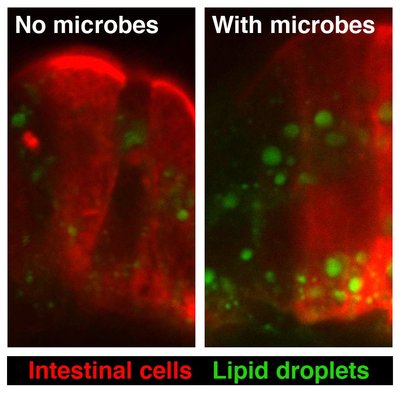Gut microbes and obesity
A new study has revealed that some gut microbes increase the absorption of dietary fats, allowing the host organism to extract more calories from the same amount of food. You may think you have your food all to yourself, but you’re actually sharing it with the 100 trillion, give or take a few, microbes in your gut.
This microflora has long been an exciting place for scientists to hunt. Thirty years ago there was a school of thought that maintained that artificial colours altered the balance of gut microbes, allowing the proliferation of microbes that excreted phenolic compounds. It was these compounds that were absorbed by children and caused the behavioural changes that parents were blaming on the artificial colours. This explanation neatly explained how the colours could affect behaviour when they were unable to cross the intestinal wall and get into the children.
Now a study from the University of North Carolina School of Medicine has demonstrated that microbes can promote the absorption of dietary fats in the intestine and their subsequent metabolism in the body.
Previous studies showed gut microbes aid in the breakdown of complex carbohydrates, but their role in dietary fat metabolism remained a mystery, until now. The research was published in the 13 September 2012 issue of the journal Cell Host & Microbe.
The study was carried out in zebrafish, which are optically transparent when young. By feeding the fish fatty acids tagged with fluorescent dye, the researchers were able to directly observe the absorption and transport of fats in the presence or absence of gut microbes.

The researchers pinpointed one group of bacteria - Firmicutes - as instrumental in increasing fat absorption. They also found the abundance of Firmicutes in the gut was influenced by diet: fish fed normally had more Firmicutes bacteria compared to fish that were denied food for several days. Other studies have linked a higher relative abundance of Firmicutes in the gut with obesity in humans.
The findings indicate that the gut microbiota can increase the host’s ability to harvest calories from the diet by stimulating fat absorption. Another implication is that diet history could impact fat absorption by changing the abundance of certain microbes, such as Firmicutes, that promote fat absorption.
Although the study involved only fish, not humans, the researchers say it offers insights that could help inform new approaches to treating obesity and other disorders. If we can understand how specific gut bacteria are able to stimulate absorption of dietary fat, we may be able to use that information to develop new ways to reduce fat absorption in the context of obesity and associated metabolic diseases, and to enhance fat absorption in the context of malnutrition.
Beany flavour study to enhance the appeal of soy-based foods
A scientific study at the University of Missouri is exploring novel ways to improve the flavour...
FCR image bank provides precise food cue feedback
GMU's Food Cue Reactivity image bank update produces more accurate and consistent...
Aust and NZ baby food nutritional claims unfounded: study
New research has shown that baby foods often feature misleading claims aimed at convincing...











